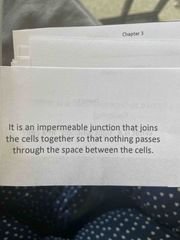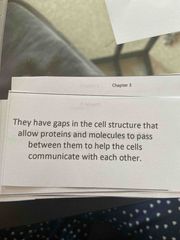![]()
![]()
![]()
Use LEFT and RIGHT arrow keys to navigate between flashcards;
Use UP and DOWN arrow keys to flip the card;
H to show hint;
A reads text to speech;
29 Cards in this Set
- Front
- Back
|
Give the steps of tissues repair |
1. Injury 2. Inflammation (swelling, pain) 3. Granulation tissue forms (scab) 4. Regeneration and fibrosis (scab falls off) |
|
|
What is peristalsis? |
Wavelike activity that propels movement (like you poop moving through your bowels) |
|
|
Which heals better and faster:clean cuts or ragged cuts? |
Clean cuts |
|
|
What is the mist important thing to know about ATP? What does it do for your body? |
ATP=energy. Anything that requires energy in the body requires ATP. Without ATP, you would die in seconds as your body wouldn’t have the energy to do something as simple as a heartbeat. |
|
|
Name 4 different types of tissue |
Epithelial; connective; muscle; nervous |
|
|
How many layers does a “simple” layer have? What about a “stratified “ layer? |
Simple -1 layer thick Stratified - more that 1 layer thick |
|
|
There are 2 different types of glands that organs have: |
Endocrine glands- ductless, secrets substances (hormones) into the blood vessels. Exocrine glands - secrets through ducts to the surface of epithelial cells (sweat and oils). Remember “external” can also be in to a body cavity. |
|
|
What is the purpose of connective tissue? |
Protection Binding Support |
|
|
Name some types of connective tissue |
Bone Cartilage Blood Loose connective tissue Dense connective tissue |
|
|
Name some uses for cartilage in the body |
Trachea Attaches ribs to breastbone Covers ends of long bones Entire fetal skeleton prior to birth Growth plates in long bones |
|
|
Name some types of dense connective tissue |
Tendons Ligaments Dermis (lower layers of skin) |
|
|
Why does the body have blood? |
It’s a transport system. A highway for nutrients and wastes and gasses to travel throughout the body and into the cells. |
|
|
Name 3 types of muscle tissue |
Skeletal Cardiac Smooth (inside the hollow organs and blood vessels) |
|
|
What is a “tight junction” in a cell? |

Back (Definition) |
|
|
What is a “desmosomes” as part of a cell junction? |

Back (Definition) |
|
|
What are gap junctions in a cell? |

Back (Definition) |
|
|
What is known as the “power house” of the cell? Why? |
Mitochondria This is where ATP is made |
|
|
Which part of a cell makes proteins? |
Golgi apparatus |
|
|
What is the name of the finger like projections that are in cells and cause movement or absorption? |
Microvilli |
|
|
Name 7 functions that cells have the ability to do |
Metabolize Digest food Dispose of wastes Reproduce Grow Move Respond to atimulus |
|
|
A solution can be something like blood, intercellular fluid, extracellular fluid. What are the 2 parts and give an example of each. |
Solvent - water Solutes - proteins, minerals, salts, hormones |
|
|
What are the 2 methods of transport that can happen in a cell to move substances across a membrane? |
Active - needs ATP Passive - pushes themselves through |
|
|
What is osmosis membrane transport? |

Back (Definition) |
|
|
What part of the cell is DNA stored in? |
The nucleus |
|
|
What does it mean when cells are “hydrophilic”? |
Water loving |
|
|
There are 3 main regions or parts to a cell. What are they? |
Nucleus Cytoplasm Plasma membrane |
|
|
The plasma membrane of a cell is otherwise known as the _____ |
Cell wall |
|
|
What does it mean when cells are “hydrophobic “? |
Water fearing/hating |
|
|
What is excocytosis? |
Where material is carried to the outside or cell in a sac called the “vesicle” |

